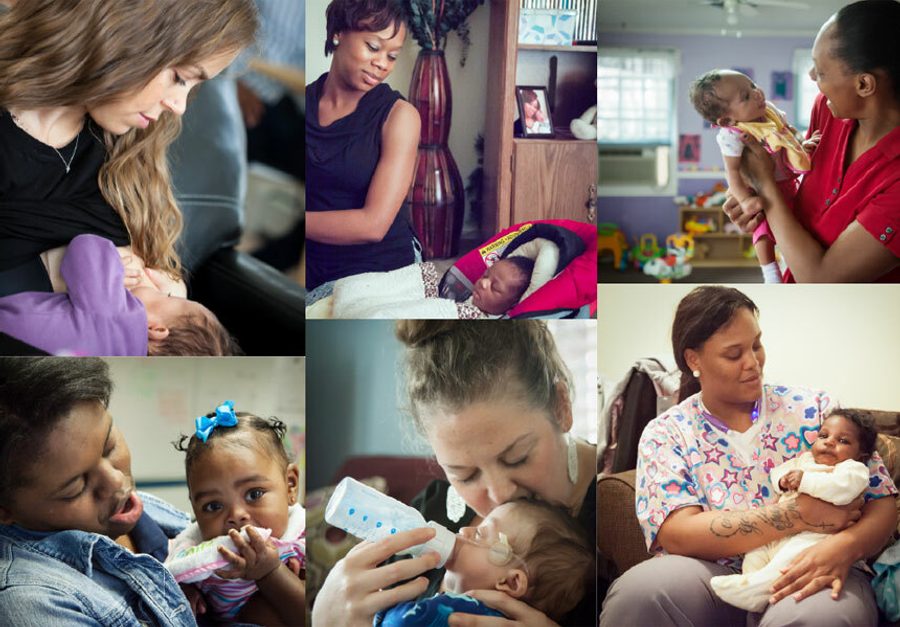The Real War on Families: Why the U.S. Needs Paid Leave Now
Investigation reveals the devastating effects of the lack of paid family leave: Our data show nearly 1 in 4 employed mothers return to work within two weeks of childbirth.
Sharon Lerner

Leigh Benrahou began laying plans to have a second child almost as soon as she had her first, a daughter named Johara, in 2011. Benrahou, 32, wanted to time the next birth so that when she returned to work, her mother, who works at an elementary school and has summers off, could babysit. Most importantly, Benrahou wanted to spend as much time as she could with her new baby while also keeping her relatively new job as the registrar at a small college.
While her husband, Rachid, 38, earns enough at a carpet cleaning company to cover their mortgage and food, without her paycheck they’d be forced to live close to the bone. And if she quit her job, Benrahou, who has a masters in nonprofit management, would take a big step backward in what she hoped would be a long career in higher education.
So Benrahou, who has wavy dark blond hair, blue eyes and a tendency to smile even through difficult moments, set about what may be the least romantic aspect of family planning in the United States: figuring out how to maximize time with a newborn while staying solvent, employed and, ideally, sane.
Only in America
Most people are aware that Americans have a raw deal when it comes to maternity leave. Perhaps they’ve heard about Sweden, with its drool-inducing 16 months of paid parental leave, or Finland, where, after about 9 months of paid leave, the mother or father can take — or split — additional paid “child care leave” until the child’s third birthday.
But most Americans don’t realize quite how out of step we are. It’s not just wealthy, social democratic Nordic countries that make us look bad. With the exception of a few small countries like Papua New Guinea and Suriname, every other nation in the world — rich or poor — now requires paid maternity leave.
Paid parental leave frees mothers and fathers from choosing between their careers and time with their infants. For women, still most often the primary caregivers of young children, this results in higher employment rates, which in turn translates to lower poverty rates among mothers and their children.
Research shows that paid leave can also be a matter of life and death for children. By charting the correlation between death rates and paid leave in 16 European countries, Christopher Ruhm, a professor of public policy and economics at the University of Virginia, found that a 50-week extension in paid leave was associated with a 20 percent dip in infant deaths. (The biggest drop was in deaths of babies between 1 month and 1 year old, though mortality of children between 1 and 5 years also decreased as paid leave went up.)
According to the Bureau of Labor Statistics, only about 13 percent of U.S. workers have access to any form of paid family leave, which includes parental leave and other time off to care for a family member. The highest-paid workers are most likely to have it, according to BLS numbers, with more than 1 in 5 of the top 10 percent of earners getting paid family leave, compared to 1 in 20 in the bottom quartile. Unionized workers are more likely to get benefits than nonunionized workers.
What do the rest of American women do without a law that guarantees this basic support? Some new mothers who don’t get paid leave quit their jobs, which can leave them desperate for income and have serious consequences in terms of work opportunities and lifetime earnings. Others may choose not to have children (though it’s impossible to definitively quantify how the difficulty of integrating work and childbirth factors into those decisions). And some try to stitch together their own paid leaves through accumulated vacation time and personal days, or through independently purchased insurance policies.
The best-laid plans
Though her employer doesn’t offer paid leave, Benrahou figured she’d create her own, taking time away from work through the Family and Medical Leave Act, which entitles new parents to up to 12 weeks off, unpaid. She knew all about the law’s loopholes — that, for instance, it only applies to workplaces that have at least 50 employees. Hers did; she wouldn’t have taken the job if it hadn’t. She knew, too, that she had to have worked for her employer for at least 12 months to qualify. That part was trickier.
She had started her job in February 2014, which meant that she wouldn’t qualify until the following February. She counted back nine months from then and got to May, but then, to be safe, tacked on another two months in case the baby came early, so: July. That’s when she and Rachid would start trying for a second.
Then there was money. Reluctant to lose 12 weeks of income, Benrahou decided to opt into her employer’s disability insurance policy, paying roughly $40 a month into the plan so she could receive 60 percent of her salary for up to six weeks of her maternity leave, plus an additional $1,000 toward the cost of her hospital stay. She would also save up her two weeks of annual paid vacation time.
Numbers crunched and policy purchased, Benrahou went off birth control on schedule in July and became pregnant within a month. But her carefully laid plans started to go awry in her 20th week, when she was diagnosed with placenta previa, which can result in early delivery. Despite some bleeding and cramping, and several brief hospital stays that used up her sick days, Benrahou stuck to her plan, working as much as possible after her diagnosis in order to save her precious vacation time. But, in late December, her water broke. Though her due date was April 1, Leigh Benrahou gave birth by C-section on Christmas Eve — too soon to qualify for FMLA leave or any payoff from her disability insurance.
Ramzi Benrahou was born at 26 weeks and just over 2 pounds. Knowing that 20 percent of babies born at his gestational age don’t survive, Leigh spent the first hours after the delivery singularly focused on her tiny son’s survival. He needed oxygen, since his lungs weren’t fully developed. And, when he was whisked away for medical attention, Benrahou had to attend to another crisis: She was the mother of a very sick baby, and her carefully constructed paid maternity leave had disintegrated. So, freshly stitched up and still groggy from anesthesia, she spread out her medical fact sheets, insurance policy papers and lists of phone numbers on her hospital bed and began to grapple with her new reality. Though her college was on winter break, which put off her return by about a week, Benrahou realized she’d have to go back to work when classes resumed on January 6, less than two weeks after giving birth.
Less than a month
Like Benrahou, most U.S. women end up returning to work sooner than they’d like — sometimes just weeks or days after having a baby. Just how soon they’re going back is difficult to determine. We know that most employers don’t offer paid leave, but no federal agency collects regular statistics on how much post-childbirth time off, paid or unpaid, women are actually taking.
Census data on employment patterns among first-time mothers show that between 2005 and 2007, more than half who worked during their pregnancy were back on the job within three months of giving birth. A 2008 study by the Department of Health and Human Services’ Maternal and Child Health Bureau, meanwhile, found that the average length of maternity leave, when taken, was 10 weeks. But more recent data is scarce, even though the recession left many women living on razorthin margins, ratcheting up the pressure to rush back to work after giving birth.
How are new mothers faring in today’s age of austerity? Data analyzed for In These Times by Abt Associates, a research and evaluation company, provides a window into these experiences. Abt went back to a 2012 survey it conducted for the Department of Labor of 2,852 employees who had taken family or medical leave in the last year, looking specifically at the 93 women who took time off work to care for a new baby.
Nearly 12 percent of those women took off only a week or less. Another 11 percent took between one and two weeks off. That means that about 23 percent — nearly 1 in 4 — of the women interviewed were back at work within two weeks of having a child.
The educational divide between those who took shorter and relatively longer leaves is striking: 80 percent of college graduates took at least six weeks off to care for a new baby, but only 54 percent of women without college degrees did so.

Pumping in the parking lot
What’s it like to be back on the job in the first weeks after having a baby?
For Natasha Long, who was back three weeks after her third child, Jayden, was born in 2012, the worst part was missing out on bonding time with her son.
Long, who was 29 at the time, was determined to make sure Jayden got breast milk. But the factory where she worked, ACCO Office Supplies in Booneville, Mississippi, didn’t have a lactation room. So when she was on breaks, she had to run out to her truck. She sat in the cab, worried that someone might see her, and pumped, while tears rolled down her face and over the plastic suction cups attached to her breasts.
Long cried because she wanted to be holding her baby rather than sitting in the parking lot of a factory in her old Yukon Denali. But exhaustion clearly also played a role in her emotional state. Her job was simple — to place stickers with the company logo on the bottom right-hand corner of plastic binders and then box up the binders. But the shifts were long — from 6 a.m. to 6 p.m. — and she put in four or five a week. Because the factory was an hour’s drive from her home in Okalona, Mississippi, Long had only 10 hours left in the day to do everything else, including tend to her three children, spend time with Jayden’s father, and sleep. By the time she got back in the evening, her children, who were being looked after by her father during the day, were on their way to bed. To pump breast milk before leaving for work, she had to get up at 4 a.m.
After just a few days of this crazed schedule, Long began to develop strange symptoms, including a headache that never seemed to go away and a choking sensation that left her feeling breathless. She started biting her fingernails to the quick — something she’d never done before — and crying a lot. “I felt like I was alone,” says Long. “I wanted to fall off the face of the earth.” Long had never been depressed. But when she went to the doctor, he surmised that her physical symptoms were rooted in her mental state, which was itself rooted in her schedule. When her doctor said he thought she was depressed, Long worried that if child welfare authorities found out, they might take her children away. She had seen other people’s children put in foster care. But when her doctor prescribed her antidepressants, she took them.
Long is not the only one to suffer emotionally from a quick return to work. Research has shown that longer maternity leaves, whether paid or unpaid, are associated with a decline in depressive symptoms, a reduction in the likelihood of severe depression, and an improvement in overall maternal health, according to a working paper issued by the National Bureau of Economic Research. One national study of 1,762 mothers found that a one-week increase in maternity leave was associated with a 5 to 6 percent reduction in depressive symptoms from six to 24 months after birth. Another found that women who took less than eight weeks of paid leave experienced more depression than those who had longer leaves and were in worse health overall. Mothers who work more than 40 hours a week, as Long was, were more likely to be depressed than those who worked 40 hours or less, according to a study by Child Trends, a research center.
Women who go back sooner also tend to breastfeed less, which cuts into the benefits breast milk confers, including better immunity and lower rates of childhood obesity, allergies and sudden infant death syndrome. It was only through heroic efforts that Long was able to breastfeed Jayden until he was 1.
Shorter maternity leaves may also have a negative effect on the development of early motor and social skills and even, later, on vocabulary, according to several studies. So far, Jayden, 3, hasn’t shown signs of missing any developmental milestones. What nags at Long is the thought that her absence in those first few months might have affected their relationship. He refuses to call her “mama,” and although there’s no research to indicate this would be a result of failed early bonding, she still fears that’s the reason.
Too busy to fight
For low-income women, the lack of paid maternity leave is just one of many missing supports to help them stay afloat while bringing new life into the world. By the time Jayden was born, pregnancy had already put Long in a perilous financial situation. She was on bed rest for the last four and a half months of her pregnancy. Big Dollar, where she worked at the time, didn’t fire her for not coming in — but it didn’t pay her, either. So Long filed for public assistance, which required her to attend classes. Though Mississippi is supposed to exempt people who are physically unable to take such classes, and Long’s doctor had warned her to stay off her feet, she says she was denied benefits when she didn’t attend.
Family members pitched in to pay for her groceries and rent while she was unable to work, but by the time Jayden was born (healthy, at 37 weeks), Long knew she had reached the limit of their generosity. When she went back to work at the dollar store, they offered her only reduced hours. It wasn’t enough to repay her debts, so she went to an employment agency, made no mention of her days-old baby, and got her job at ACCO.
Other social supports are glaringly absent for U.S. mothers, especially poor ones, who fill waiting lists for scarce subsidized childcare spots and underfunded early education classes. In comparison, Sweden and Denmark spend roughly 10 times what we do on childcare per person.
Without adequate options or support, low-income workers, who are more likely to live paycheck to paycheck and less likely to have access to any type of leave, often have little choice but to power through. As our data confirm — and as finances dictate — less educated women, who tend to have lower-paying jobs, are likely to take less time off after having children. Often, that means not just going back to work early, but going back to very long work hours, very early.
Raven Osborne, for instance, a 22-year-old single mother in Tupelo, Mississippi, went back to work just one week after her first child, Kylan, now 2, was born in August 2013. In addition to being a full-time college student, Osborne was waitressing full-time at IHOP, but her earnings — tips plus a base salary of $2.13 an hour — weren’t enough to cover her rent, car payments and daycare costs. Perhaps ironically, her tips were much higher — sometimes more than $100 a shift — when she was visibly pregnant. But once she had the child, they went down again, so Osborne added a few overnight shifts at Texaco when Kylan was four weeks old, leaving the baby with his grandmother. Working upwards of 60 hours each week, the new mother barely saw her son, except when she got home from work, when she often fell asleep holding him. She could have taken unpaid leave from IHOP but chose not to because she needed the pay.
This winter, Osborne returned to work four weeks after her second child, Anthony, was born. Now she’s working full-time at a debt collection agency on top of several shifts at the nearby Coles supermarket.
“I don’t like asking for help” is how Osborne explains the frantic pace she’s kept up during her first year-and-a-half of motherhood. Her mother pitches in by watching the kids when she can, though she, too, has two full-time jobs — one at Walmart and another as an aide at a retirement community.
Clearly, women with low earnings are the least likely to have a financial cushion that allows them to forgo a paycheck. But it’s not only those on the bottom of the pay scale who can’t afford to take unpaid leave. More than 2.5 million employees need time off from work to care for themselves or another but can’t afford to take it, according to a 2012 study from the Center for Economic and Policy Research.
Tracy Malloy-Curtis, a fundraiser at a nonprofit in New York City, could have taken more time off, unpaid but with job security, after she had a baby a few years back. (“It’s a civil rights organization,” she explains, though she doesn’t want to name it because she still works in the field.) Instead, Malloy-Curtis, who is 43, married, and the primary breadwinner in her family, went back five and a half weeks after having a son — and a complicated C-section — for fear she otherwise could not afford to pay her mortgage and cover the other basic costs of her life.
“Physically, I was a wreck,” she says. An infection around her C-section wound hadn’t yet healed when she went back to work. “I was still bleeding, my incision wasn’t closed.” Pus dripped down her leg under her work clothes.
Those who do take leave may find themselves penalized afterward. Jackie Wheeler took six weeks of paid maternity leave after her son, Enzo, was born in 2011. Wheeler, who lives in Westminster, Colo., was working at the front desk of a local branch of Chase Bank. Though her son had severe medical problems as a result of being born early, Wheeler had intended to go back to her job. Before giving birth, she says, she had even been talking with her boss about interviewing for an assistant manager position. “I saw myself as moving along in the company,” she says.
But after she returned to work and Enzo was released from the hospital, she took another six weeks of leave. At that point, her boss told her he thought it was best that she resign — if he didn’t fill her position right away, he said, corporate headquarters would eliminate it. And Wheeler was too overwhelmed at the time to challenge him.
The birth of hope
While, in the United States, the lack of time off can too often turn new motherhood into a distressing ordeal, most other cultures treat this immediate post-natal period as a sacred time, when both the new mother and baby receive help and special attention. Throughout history and all over the world, people have tended to carve out a minimum of at least six weeks in which women are exempt from responsibilities other than child care, according to Malin Eberhard-Gran, a Norwegian public health scholar who has compiled a cross-cultural comparison of post-natal practices.
In some Muslim traditions, new mothers spend the first 40 days after birth in their mothers’ homes, for instance. Many Latin American cultures also bracket during the same period, known as la cuarantena (from the Spanish word for “forty”), and exempt women from work responsibilities. In some other countries, women are granted special treatment for even longer. Traditionally, women in Japan and India go to their mothers’ homes for several months after giving birth. And today, by law, the 30 countries in the Organization for Economic Co-operation and Development (OECD) — democracies with market economies — provide an average of more than a year of paid leave.
Here in the United States, advocates have been fighting for a century to get new parents just a few weeks off with pay. But the tide may be turning. In 2002, California became the first state to pass a paid family leave law, which provides workers who need to care for a new baby with 55 percent of their usual weekly pay, to a limit of $1,104 for up to six weeks. New Jersey passed a similar law in 2008. And in 2013, Rhode Island granted workers up to four weeks off with pay for “family care,” including care of a new baby. Despite dire warnings from business interests, most employers in New Jersey and California (where programs have been in effect long enough to be studied) haven’t found that paid leave has hurt productivity, profitability or turnover. (Full disclosure: I was a co-author of the New Jersey study).
The Obama administration is attempting to build momentum for paid sick leave, one of the main ways women piece together paid maternity leave. In the 2015 State of the Union address, President Obama called on Congress to send him a bill guaranteeing U.S. workers seven days of paid sick leave — but in early August, Senate Republicans blocked a Democrat-sponsored bill to do so. In the meantime, Obama has an executive order in the works that will extend a week of paid sick leave to all federal contractors, and his adminstration has issued $1.25 million in grants to study how paid leave programs can be developed in states. Labor Secretary Tom Perez, who has been outspoken on the issue, has spearheaded a #leadonleave campaign, in which he and White House aide Valerie Jarrett travel the country to boost local paid leave policies.
But, so far, even a Democratic administration committed to the issue hasn’t been enough to overcome resistance to it. When bills have been debated in states, Republicans have been so vehement that paid leave is bad for business and a “job killer” that legislation at a federal level has been assumed to be a no-go. And, at least until very recently, congressional Republicans have mostly scoffed at Democratic efforts. But for the first time, a bill proposed by Sens. Kirsten Gillibrand (D-N.Y.) and Rosa DeLauro (D-Conn.) this spring that would provide benefits for workers who take time off to care for a new baby or sick family member was met with a counterproposal from Republicans, which would allow hourly workers to put overtime toward paid leave.
The issue is also clearly gaining ground in certain states, where at least ten family leave proposals have been introduced since March. Though Republican presidential candidates have had little to say about the issue, Democratic contenders Hillary Clinton and Bernie Sanders have both come out as strong proponents of paid leave. While Sanders has been more specific about his plan, calling for 12 weeks off, with pay, both are making a moral case to which there is no politically sound retort: Families need paid time off to take care of their new babies. Men, women and children will gain from this basic human dignity.
Barreling ahead
After three months, Leigh Benrahou only has a blurry recollection of her first weeks back at work just days after her premature son was born. “I remember walking really slow and wearing stretch pants and just making it happen,” she says hazily. She spent those early days cutting a path between the college; the hospital’s neonatal intensive care unit (NICU), where Ramzi spent four months and underwent two stomach surgeries; her 3-year-old daughter’s daycare center; and her home, where, despite her exhaustion, she found it difficult to sleep.
At work, Benrahou tended to the needs of her students, whose questions about enrollment requirements and course changes occasionally provided distraction from her own, far graver problems. But mostly it was surreal — and painful — to be there. Climbing stairs was difficult because of her recent surgery. And pretty much every time she closed the door to pump breast milk, she wound up crying. Harder still was being away from her tiny baby, whose health was still so uncertain. Every time she got a call from the hospital when she was at work — and there were many — her stomach clutched.
“They say it’s like being on a roller coaster, [having a child] in the NICU,” says Benrahou. “But a roller coaster is fun. I wanted to throw up all the time.”
Benrahou didn’t throw up, though. Instead, like so many other American women, she barreled ahead, doing her best to both take care of her newborn and remain employed. Though she never got to take leave when and how she had planned, she was recently able to take 12 weeks off through the FMLA under the category of caring for a sick relative — in this case, her infant son. And now the woman who so painstakingly planned her family’s future doesn’t know what’s ahead. Ramzi’s long-term prognosis is unclear; he’s still on oxygen and has a feeding tube. About a quarter of babies born at 26 weeks go on to have lasting disabilities.
Benrahou’s hope is to keep working. And mostly she remains upbeat. But sometimes she can’t help but wonder whether Ramzi’s early birth was preventable; and whether continuing to work after her diagnosis so she could make the best of her miniscule amount of time off brought about Ramzi’s early delivery. It certainly wasn’t the way she planned it.
This article was supported by the Leonard C. Goodman Institute for Investigative Reporting.
SPECIAL DEAL: Subscribe to our award-winning print magazine, a publication Bernie Sanders calls "unapologetically on the side of social and economic justice," for just $1 an issue! That means you'll get 10 issues a year for $9.95.





